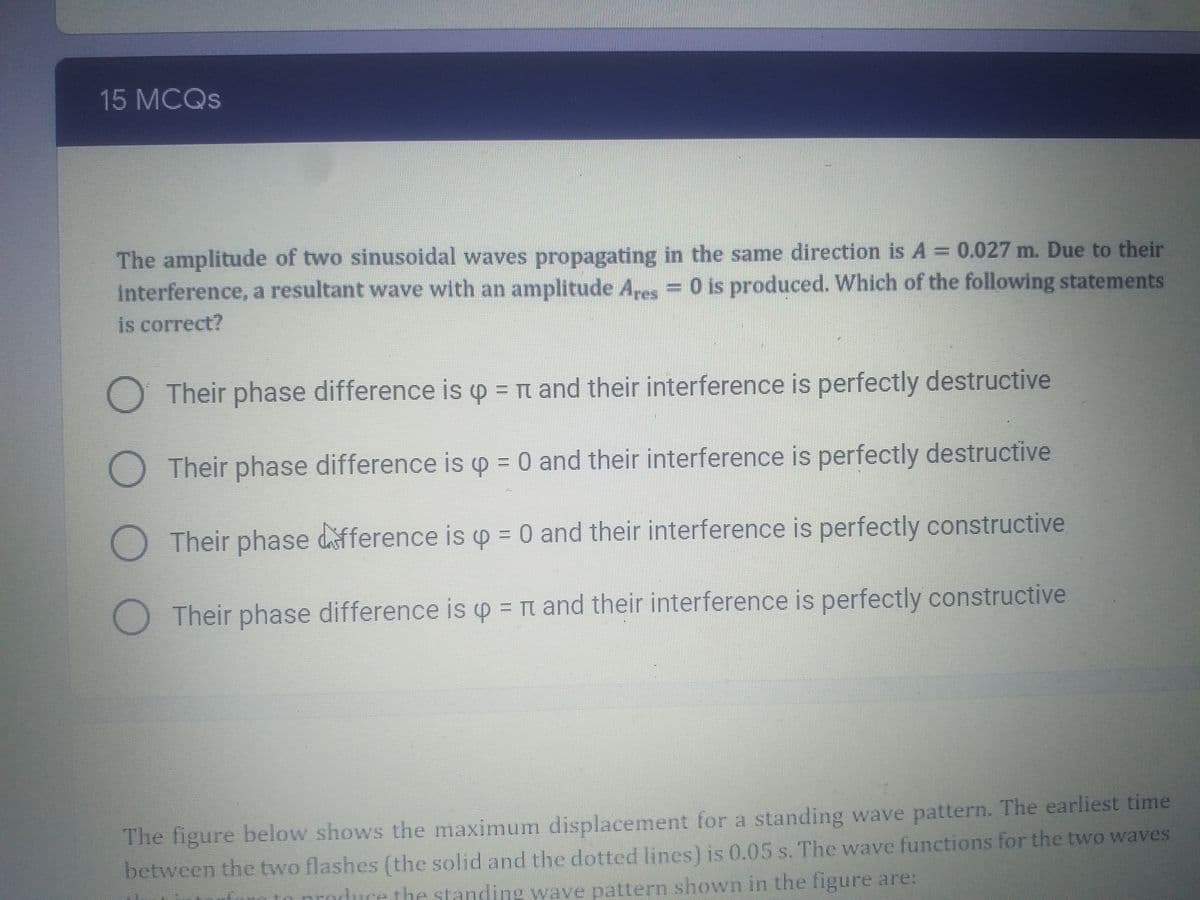The amplitude of two sinusoidal waves propagating in the same direction is A = 0.027 m. Due to their interference, a resultant wave with an amplitude Ares is correct? = 0 is produced. Which of the following statements
The amplitude of two sinusoidal waves propagating in the same direction is A = 0.027 m. Due to their interference, a resultant wave with an amplitude Ares is correct? = 0 is produced. Which of the following statements
Physics for Scientists and Engineers
10th Edition
ISBN:9781337553278
Author:Raymond A. Serway, John W. Jewett
Publisher:Raymond A. Serway, John W. Jewett
Chapter17: Superposition And Standing Waves
Section: Chapter Questions
Problem 6P: Two identical loudspeakers 10.0 m apart are driven by the same oscillator with a frequency of f =...
Related questions
Question

Transcribed Image Text:15 MCQS
The amplitude of two sinusoidal waves propagating in the same direction is A = 0.027 m. Due to their
interference, a resultant wave with an amplitude A,es = 0 is produced. Which of the following statements
is correct?
Their phase difference is o = n and their interference is perfectly destructive
O Their phase difference is p = 0 and their interference is perfectly destructive
O Their phase difference is o = 0 and their interference is perfectly constructive
O Their phase difference is p = t and their interference is perfectly constructive
The figure below shows the maximum displacement for a standing wave pattern. The earliest time
between the two flashes (the solid and the dotted lines) is 0.05 s. The wave functions for the two waves
to produce the standing wave pattern shown in the figure are:
Expert Solution
This question has been solved!
Explore an expertly crafted, step-by-step solution for a thorough understanding of key concepts.
Step by step
Solved in 2 steps

Knowledge Booster
Learn more about
Need a deep-dive on the concept behind this application? Look no further. Learn more about this topic, physics and related others by exploring similar questions and additional content below.Recommended textbooks for you

Physics for Scientists and Engineers
Physics
ISBN:
9781337553278
Author:
Raymond A. Serway, John W. Jewett
Publisher:
Cengage Learning

Physics for Scientists and Engineers with Modern …
Physics
ISBN:
9781337553292
Author:
Raymond A. Serway, John W. Jewett
Publisher:
Cengage Learning

Principles of Physics: A Calculus-Based Text
Physics
ISBN:
9781133104261
Author:
Raymond A. Serway, John W. Jewett
Publisher:
Cengage Learning

Physics for Scientists and Engineers
Physics
ISBN:
9781337553278
Author:
Raymond A. Serway, John W. Jewett
Publisher:
Cengage Learning

Physics for Scientists and Engineers with Modern …
Physics
ISBN:
9781337553292
Author:
Raymond A. Serway, John W. Jewett
Publisher:
Cengage Learning

Principles of Physics: A Calculus-Based Text
Physics
ISBN:
9781133104261
Author:
Raymond A. Serway, John W. Jewett
Publisher:
Cengage Learning

University Physics Volume 1
Physics
ISBN:
9781938168277
Author:
William Moebs, Samuel J. Ling, Jeff Sanny
Publisher:
OpenStax - Rice University

Physics for Scientists and Engineers, Technology …
Physics
ISBN:
9781305116399
Author:
Raymond A. Serway, John W. Jewett
Publisher:
Cengage Learning

An Introduction to Physical Science
Physics
ISBN:
9781305079137
Author:
James Shipman, Jerry D. Wilson, Charles A. Higgins, Omar Torres
Publisher:
Cengage Learning